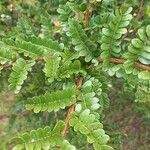A small, many-branched tree 3-5 m in height, often shrubby, with a twisted, gnarled trunk and stiff, pale branches. Bark: charcoal-grey, rather smooth, the larger stems tending to be cracked and fissured longitudinally. Leaves: fine and feathery, tending to be crowded on short spur-branchlets which are sometimes spine-tipped, with 6-18 pairs of leaflets; leaflets small, linear to oblong, 0.5-2.5 x 0.15-1 cm, dark green; apex very broadly tapering to rounded; base rounded, asymmetric; margin entire; petiole 2-4 mm long. Flowers: very showy, producing red splashes of colour in the dry countryside; sepals red; petals usually red but sometimes pink, up to 2.5 cm long; stamens free; in dense, branched heads or panicles about 7-8 cm long, on short spur-branchlets or, very occasionally, terminal. Fruit: a woody pod, shortly oblong, 5.5-12 x 3-3.5 cm, the hard rim persisting. Seeds: roundish, slightly flattened, pale brown, without yellow aril.
A shrub or much branched small tree. It grows up to 6 m tall. It has several stout, thick, twisted stems. The leaves are usually dark green. The smooth grey twigs can be seen among the leaves. The leaves divide once. There is a pair of leaflets at the end and the leaflets tend to fold up along the midrib. The midrib is sometimes winged. There are 6-8 pairs of leaflets. They vary from 6-25 mm long. The flowers are red. They occur in bunches on short woody side twigs. The flowers have 5 petals. The pods are 5-13 cm long and 4 cm wide. They are hard and woody. There are several round brown seeds. They are edible.
Much-branched shrub or small tree, up to 3-5 m high; crown spreading. Bark rough, brown. Leaflets 6-18 pairs, opposite, sessile, linear or oblong-elliptic, oblique basally, apex obtuse, mucronate, ± pubescent. Inflorescence a many-flowered, congested, subglobose panicle, on short lateral branches. Flowers scarlet or pink. Calyx coriaceous; tube obconical, lobes usually 4 (sometimes one emarginate or divided to base to give 5 lobes), obovate to oblong. Flowering time all year, mostly Sept.-Jan.
Much-branched shrub or tree, 3-5 m tall, trunk gnarled, with charcoal-grey bark. Leaves crowded on short spur-branchlets, pinnate, leaflets in 12-18 pairs, linear to oblong. Flowers in congested, branched heads or panicles, up to 25 mm long, showy, red or occasionally pink. Pod shortly oblong, woody, with a persistent hard rim.
Much-branched shrub or tree, 3-7 m. Leaves pinnate, leaflet pairs 6-18. Flowers in congested panicles, red or pink, filaments free.


